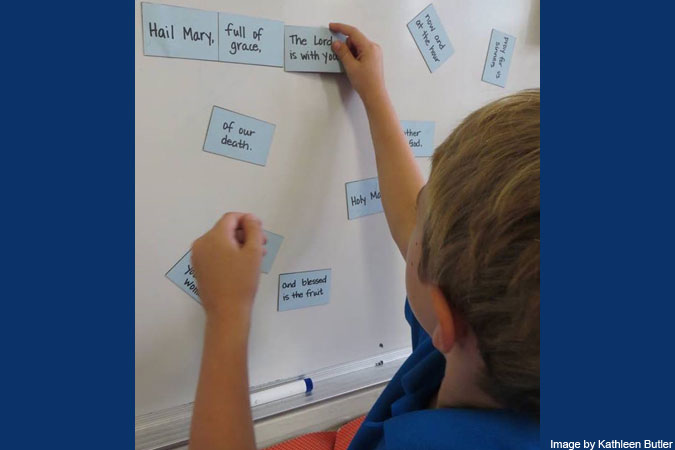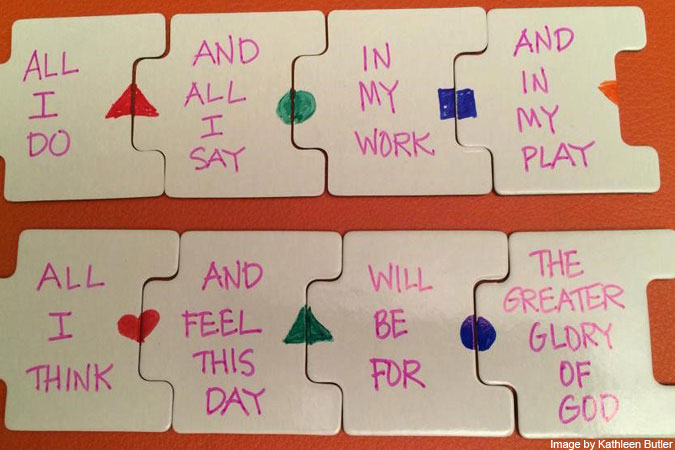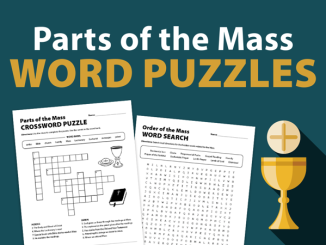
You don’t need the latest technology to capture your students’ attention. They’re probably so plugged in during their day that low-tech (or no-tech) activities will seem novel. I have created a variety of resources with nothing more than markers and construction paper. Add variety to your lesson by incorporating activities that use low-cost teaching supplies. Make sure that whatever you create has a learning component to it.
Flash Cards
Buy pre-cut flashcards or simply cut out some construction paper to make prayer puzzles. Write one word to a common prayer—such as the Lord’s Prayer or the Hail Mary—on each individual card. Mix up the cards and have students place the words in the proper order. Ask them to pray the prayer together when they’ve finished. My students came up with their own ideas. They race to see who can put the words to the prayer in the correct order; they also race to place the words in reverse order.
If your parish has a laminator, laminate the cards to prolong their life. You can also buy self-adhesive laminating sheets and do it yourself. Have several sets of flash cards on hand. Color-code the flash cards to keep them organized; you can use different colored paper or markers. As the year progresses, create more sets of flash cards with new prayers. If you have younger students who aren’t strong readers, have them work with a classmate. By adding self-adhesive magnets to the back of the flash cards, you can have students place the cards on a white board.
I also use flash cards to play memory games. Create pairs of items and challenge the children to match them up. You could create versions with specific themes, such as the Mass or the saints. If you’re an artist, draw the matching items. If you’re not an artist, you can use clip art or use word matches. Because this activity is meant for learning as well as for fun, the rule in our class is that in order to keep your match, you have to say something about your match. For example, if the match was the picture of a priest, the student might say the pastor’s name for the priest match.
Puzzles

You can purchase blank puzzles in a variety of sizes. This allows you to adjust the level of difficulty for the age group. Write words to a prayer on individual pieces. If you have non-readers, you can put a symbol on the pieces as clues to help them. For example, you can use matching shapes to indicate interlocking pieces. Create your own puzzle sheets, and let your students design their own puzzles, either with words or pictures.
Craft sticks can be used as puzzles. Write a line of a prayer on a stick, and let the children put the sticks in order. Students can tape the sticks together for a folding memory aid.
Games
Your closet may be a source for supplies. I created an activity from an old tumbling tower game. I wrote vocabulary words on the blocks and asked students to build a tower out of them. In order to add their block to the tower, however, children had to explain the word that was on the block. You could also build the tower in advance, and play like a regular tumbling tower game. However, I prefer the idea of building something rather than tearing something down. You can play it with teams of two, where one child has the piece with the word on it and he or she has to explain it well enough for the partner to guess the word. Then both players get to add a piece to the tower.
Play a card game using blank playing cards (available online) or with index cards. Write a vocabulary word on the card, followed by words that they cannot use. One player draws a card and has to explain the vocabulary word without using any of the “forbidden” words that are listed on the card. The object is for the player with the card to get his or her teammates to guess the vocabulary word. You can adjust the level of difficulty by adding to the list of “forbidden” words.
You can also play a guessing game. Write a vocabulary word, a name of a saint, or a concept on a card. Divide the class into two-player teams. One player draws a card and places it on his or her forehead so that the partner can read it. The player with the card then asks yes-or-no questions in order to guess what is written on the card.
These are not always quiet activities, so if you have children in your class who are sensitive to over-stimulation, have a back-up plan. What I like about these kinds of activities is that they get everyone involved and talking. They serve as great warm-up or review activities, but they also require interaction and encourage community.
What low-tech games and activities do you use in your classroom?
Lessons in God’s Gift: Reconciliation and Eucharist are explored through reading, conversation, prayer, and fun-filled activities that appeal to all learning styles.





Be the first to comment